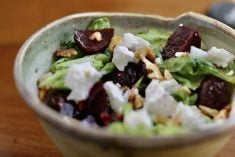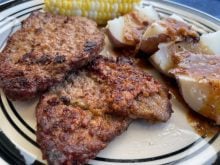Recently I went on a family fishing trip to Besnard Lake in northern Saskatchewan. While Bill, my husband, has gone many times before, it was a first for me.
It was great to experience the things I hear Bill talk about. One of those was a shore lunch. At noontime, the guide took our boats to an opening along the shore. We got out of our fishing boats, and up into the trees lining the shore. He then filleted our morning catch, built a fire from little bits of bark and twigs, followed by larger sticks. That wasn’t an easy task because it had been raining.
Read Also

Growing crops for fuel comes with challenges
Crops for sustainable aviation fuel will be the subject of much debate. Where to plant them, will farmers invest in them and how food and fuel prices will be impacted must be discussed.
The filleted fish were placed in a plastic bag and coated with flour and spices, then cooked in a big frying pan over the open fire. That is as fresh as fish can be. We had brought along veggies, fruit, pork and beans and a few potatoes to complete the lunch. Then it was back into the boats for more fishing before returning to the lodge for the evening. I don’t know if I’ll go fishing again, but I was glad to have experienced it at least once.
Enjoying chokecherries
Chokecherries are found on the Prairies in bluffs and ravines or planted in many farm shelterbelts. We have a row all around our farmyard that was planted in 1985. They survived the drought of 1988 and other dry years along the way. Now the trees are tall and big, providing shelter from the drying winds for the evergreens and other trees, the farm buildings and the people out in the yard. An added bonus is the fruit they produce.
The name chokecherry is suitable because unripe cherries are astringent and “puckery.” Fully ripe berries are more palatable, but leave a cottony sensation in the mouth. Some people marketing chokecherry products have renamed it the wild black cherry.
Fully ripe berries are black, with less ripe ranging from red to deep reddish purple. For best setting when making jelly, pick berries with some reddish colour or mix black fully ripe with some reddish.
Underripe fruit has more natural pectin, which aids in holding the cells of the fruit together. A general rule is to have three-quarters just ripe fruit and one-quarter slightly underripe fruit.
After picking, sort to discard any poor cherries, leaves or twigs. Wash thoroughly. Place cherries in a large kettle and add boiling water to barely cover the fruit. Research has shown it is better to place the berries in boiling water rather than in cold water, and then quickly return to the boiling point.
Bring to a boil and simmer for 15 minutes or just until the fruit is soft and pulpy. Crushing the fruit with a potato masher during the cooking reduces the cooking time.
While cooking is required to release the pectin from the pulp and skin, if cherries are boiled too long, the amount of pectin released makes the fruit gummy and it is harder to extract the juice.
Pour hot cooked fruit into a moistened jelly bag. Squeezing the bag increases the quantity but clouds the juice. For chokecherries, I prefer to squeeze the bag to get as much juice as possible. It gives a larger reward for the time spent picking. The juice can now be used or frozen for later use. We enjoy chokecherry jelly, syrup and the flavouring in frostings and other recipes.
The following chokecherry dessert recipe is from a little recipe book by Saskatchewan Fruit Growers Association. It features western Canadian grown fruits, including raspberries, strawberries, saskatoons, rhubarb, nanking cherries, apples and other berries. For information about buying the book, call 877-973-7848, write to Box 177, Langenburg, Sask. S0A 2A0, or e-mail cas.lyn@sasktel.net.
Chokecherry cordial dessert
Crust:
1 cup butter or shortening 250 mL
2 cups flour 500 mL
2 tablespoons sugar 30 mL
Chokecherry sauce:
3 tablespoons cornstarch 45 mL
2 cups chokecherry juice 500 mL
1 cup sugar 250 mL
pinch salt 0.5 mL
1/2 teaspoon almond extract 2 mL
Cream cheese layer:
8 ounces cream cheese 250 g
3/4 cup icing sugar 175 mL
1/4 cup frozen whipped topping, 60 mL
thawed
Topping:
2 cups frozen whipped topping, 500 mL
thawed, divided
1/2 cup chokecherry sauce 125 mL
(reserved)
Crust: Combine all ingredients. Press into a nine x 13 inch (23 x 33 cm) pan. Bake at 350 F (180 C) for 10 to 12 minutes.
Chokecherry sauce: Add cornstarch to 1/2 cup (125 mL) of cold juice. In a saucepan, add sugar to remaining juice; bring to a boil. Stir in cornstarch mixture; cook and stir until thickened. Stir in salt and almond extract. Cool.
Cheese layer: Beat cream cheese with sugar and topping; spread on crust. Pour all but 1/2 cup (125 mL) cooled chokecherry sauce over cheese layer.
Topping: Beat 3/4 cup (175 mL) whipped topping and reserved sauce together; spread over sauce in pan. Use a small spoon for best results. Garnish with remaining whipped topping. Yield: 15 servings.
Variation: This can be made into two pies instead of a nine x 13 (22 x 33) dessert. For the base, use two baked pie shells. Fill with the layers the same as for the dessert.
Source: The Fruits of our Labours by Saskatchewan Fruit Growers Association, June 2005.
Mustard pickles
Dear TEAM: My mustard pickle recipe calls for cucumbers. Can I use the long English type from my garden? – by e-mail, M. R.
Dear M.R. For mustard pickles, I’m sure the long English type would be fine. Bernardin has a tested recipe for chunky mustard pickles that uses cucumber or zucchini. If using zucchini, do not peel, and so I would do the same with the thinner skinned eating type cucumbers. The chunks would stay more intact.
The reason for using pickling cucumbers rather than the English type in dills and other types of pickles is that pickling cucumbers have thicker and stronger skins and flesh to withstand the high temperatures of processing. The finished product is more apt to be crisp if you use a pickling cucumber.
Chunky mustard pickles
14 cups prepared cucumbers 3.5 L
or zucchini
6 cups finely chopped onion 1.5 L
1/4 cup pickling salt 60 mL
3 cups sugar 750 mL
1/2 cup all-purpose flour 125 mL
1/4 cup dry mustard 60 mL
1 tablespoon ground ginger 15 mL
1 teaspoon ground turmeric 5 mL
1/2 cup water 125 mL
2 cups white vinegar 500 mL
1 large sweet red pepper,
finely chopped
Peel cucumbers unless using zucchini or English cucumbers. Cut vegetables in half lengthwise and remove seeds, using a spoon. Cut vegetables into 1/2 inch (one cm) cubes. In a large glass or stainless steel container, combine vegetables and onions; sprinkle with salt. Let stand one hour. Drain.
Place seven clean 500 mL mason jars in a boiling water canner; cover jars with water and heat to a simmer (180 F/82 C). Set screwbands aside; heat snap lids in hot water, not boiling (180 F/82 C). Keep jars and lids hot until ready to use.
In a large stainless steel saucepan, combine sugar, flour, dry mustard, ginger and turmeric. Gradually blend in water and vinegar and bring to a boil, stirring constantly. Cook until thickened, about five minutes. Add drained cucumber-onion mixture and red pepper; return to a boil, stirring constantly.
Ladle hot mixture into hot jars to within
1/2 inch (one cm) of top rim (headspace). Using nonmetallic utensil, remove air bubbles. Wipe jar rims, removing any stickiness. Centre lid on jars; apply screwbands securely and firmly until resistance is met, or fingertip tight. Do not overtighten.
Place jars in canner. Cover canner; bring water to a boil. At altitudes up to 1,000 feet (305 m), process 15 minutes. Increase the time by five minutes for each increase in altitude of up to 6,000 feet (1,830 m), up to 8,000 feet (2440 m) and to 10,000 feet (3,050 m).
Remove jars without tilting. Cool upright, undisturbed for 24 hours. Store in a cool, dark place. Yield seven jars.
Chokecherry syrup
Good on ice cream, pancakes or waffles.
4 cups chokecherry juice 1 L
61/2 cups sugar 1.6 L
2 cups corn syrup 500 mL
Place all together in a saucepan and bring to a hard rolling boil, stirring constantly. Simmer five minutes. Remove from heat. Pour into hot sterilized jars. Yield: eight cups (two L).
Source: Saskatchewan Sportsman’s Gourmet Guide by Henrietta Goplen.
Canadian grilling
The Beef Information Centre has a new 14 page beef recipe booklet called Canadian Grilling. It has information on new beef cuts from the hip and chuck portion of the carcass. Cuts featured include beef rotisserie roasts, medallions, marinating and grilling steaks and ground beef. To order your free copy, visit www.beefinfo.org.
The Beef Information Centre is a national organization established in 1973. It is the market development division of the Canadian Cattlemen’s Association and represents more than 90,000 cattle producers.
Beef Bucks is an on-line consumer sweepstakes sponsored by the Beef Information Centre. You can enter for the grand prize of $2,500, or for 50 other prizes of digital thermometers, by visiting www.beefinfo.org. The deadline for entries is Aug. 31.
Alma Copeland is a home economist from Elrose, Sask., and one of four columnists comprising Team
Resources. Send correspondence in care of this newspaper, Box 2500, Saskatoon, Sask., S7K 2C4 or contact them at team@producer.com.














